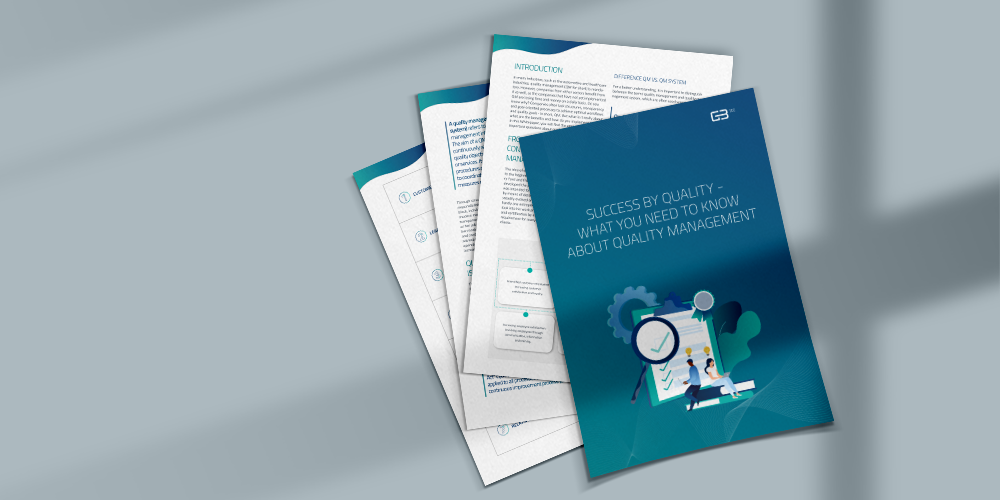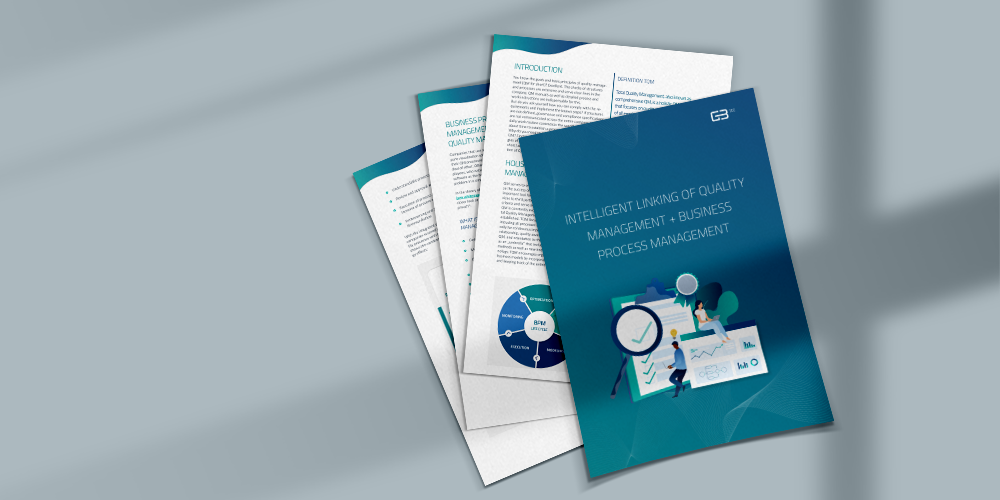ISO 9001
Customer satisfaction is vital for the success of a company. With a certification based on the ISO 9001 standard, you certify compliance with quality standards for your products and services. This enhances the trust of customers and prospects in your company and stimulates customer satisfaction.

What is ISO 9001?
ISO 9001 is an internationally recognized standard for quality management. The abbreviation "ISO" stands for the International Organization for Standardization, while "9001" is the number of the standard. ISO 9001 was initially published in 1987 and continually updated by the organization, most recently in 2015. With these updates, the ISO responds to technical and legal changes, such as the digitalization of business life.
The thought behind standardization is to elevate quality management in companies to a higher level. The aim is to meet the needs of customers and interested parties by defining quality and business processes. With the help of a continuous improvement process, ISO 9001 also provides the framework for optimizing existing processes and quality specifications in a focused manner. The standard is not limited to big corporate organizations; certification can be applied by companies of any size and industry, and the standardization can be implemented.

What are the eight principles of ISO 9001?
ISO 9001 is based on eight rules of quality management – see also info page Total Quality Management:

- Customer orientation:
The needs and requirements of customers should always be in the focus of quality management. - Leadership:
Management must take a distinct leadership role and promote a culture of quality management. - Employee involvement:
All staff members should be engaged in quality management and encouraged to make proposals for improvement. - Process-orientation:
All processes should be designed to be efficient, effective and to meet customer requirements. - Guidance:
The quality management system should be seen as a cohesive system that covers all aspects of the business. - Continuous enhancement:
The quality management system should be continuously improved to guarantee that it meets the needs of customers and other interested parties. - Decision making based on facts:
Decisions should be based on facts and data to guarantee that they are effective. - Supplier partnerships for mutual advantage:
The partnerships with suppliers should be designed in a way that is helpful for both parties.
Advantages of ISO 9001
ISO 9001 certification is suitable for businesses of all sizes, in any industry. The certification process, including official audits, provides companies the opportunity to enhance their quality management systems and set standards to better satisfy the needs of their customers and other stakeholders.
The rewards of implementing ISO 9001 include the following:
- Companies ensure that they meet the demands of their customers, therefore improving customer loyalty.
- By implementing processes and procedures, businesses optimize their operations and make them more productive.
- Control mechanisms and the monitoring of processes reduce the susceptibility to errors and rejects.
- Involvement in quality management increases staff satisfaction and encourages personal initiative.
What is the certification process?
Gaining ISO 9001 certification is typically done with the help of an accredited certification company, and involves several steps, which we will explain in more detail below.
Step 1: Preparation/Inventory
Preparation for certification is an important first step. Companies should ensure that they meet all the fundamental requirements of the standard and that their quality management systems are adequately documented. A GAP analysis can assist in recognizing and closing the gaps in a company's quality management system.
Step 2: Initial audit
The following step is to undertake initial audits by the certification company. The auditors visit the company and verify that the quality management system meets the requirements of ISO 9001. The auditors conduct interviews with personnel and review documentation to make sure that the company meets all requirements.
Step 3: Reporting and corrective measures
Once the audit is finished, the certification company compiles a report that incorporates any distinguished nonconformities or shortcomings in the company's quality management system. The company then takes corrective measures to address the identified deviations and to upgrade the system.
Step 4: Second audit
After the company has implemented the necessary corrective measures, a second audit takes place. The auditors review the quality management system once more to make sure that all corrective measures have been effective, and that the system meets the necessities of ISO 9001.
Step 5: Certification
If the company successfully passes the second audit, the certification company will issue the ISO 9001 certification. The certification is normally valid for three years, after which it must be renewed.
Step 6: Surveillance audits
Surveillance audits occur during the certification validity period to make sure that the company continues to meet the requirements of ISO 9001. These surveillance audits usually take place once a year.

Gaining ISO 9001 accreditation is a major step for companies to ensure they are enhancing their quality management systems and meeting the requirements of their customers and other stakeholders. The certification process is admittedly time-consuming and costly, though the advantages of the certification often outweigh the investments in the procedure over the long run.
Process management as a key element of ISO 9001
Process management is a central part of ISO 9001. The standard stipulates that organizations must systematically identify, document, control and improve their business processes. Processes are separated into inputs, process steps and outputs to create a transparent framework and a better overview.
ISO 9001 puts a great emphasis on the so-called "process-oriented approach". This approach states that businesses should view their processes as interconnected systems and see them in a holistic context. The focus lies on the interaction of processes and the identification of interfaces to optimize cooperation between the various departments.
Links between ISO 9001 and process management

Process identification and documentation
ISO 9001 requires organizations to identify and document all their business processes. Process management assists in keeping an overview of the processes and ensuring that all relevant information is recorded and presented in an organized manner.

Process control, -measurement and -evaluation
ISO 9001 puts strong emphasis on process control. Relevant process management techniques such as process modeling and process analysis empower companies to better control and enhance their processes. To constantly monitor and improve process performance, ISO 9001 necessitates the introduction of measurable KPIs. Process management methods such as monitoring enable the performance of processes to be measured and evaluated on a regular basis.

Continuous improvement
ISO 9001 requires constant improvement of processes and the QMS. Process management methods such as the PDCA model (Plan-Do-Check-Act) or Six Sigma enable companies to systematically identify and implement improvement potential.

Risk-based thinking
According to ISO 9001, companies must incorporate risk-based thinking into their processes. Process management methods like risk analyses help to find potential risks at an early stage and to take appropriate steps to reduce them.

Customer orientation
ISO 9001 requires that companies meet and exceed the needs and expectations of their customers. Process management helps to bring the customer perspective into the focus of business processes by enabling companies to analyze and optimize processes from a customer's perspective.

Management responsibility
ISO 9001 highlights the role of management in implementing and sustaining the QMS. Process management approaches such as process ownership and process governance guarantee that management takes responsibility for the processes and provides the necessary resources.
Ready to optimize your quality management?
Discover the process-based QM software BIC Process Design now!
With BIC Process Design you get a comprehensive software solution for your quality management. The versatile functions and user-friendly interface enable you to design your processes efficiently and in compliance with ISO 9001. Use the integrated functions for process modeling, analysis, optimization and documentation to boost your quality management to the next level.
Further resources
Here is more information on the successful implementation of process-oriented and effective quality management in your company. Take a look at our resources and enhance your process quality today!




